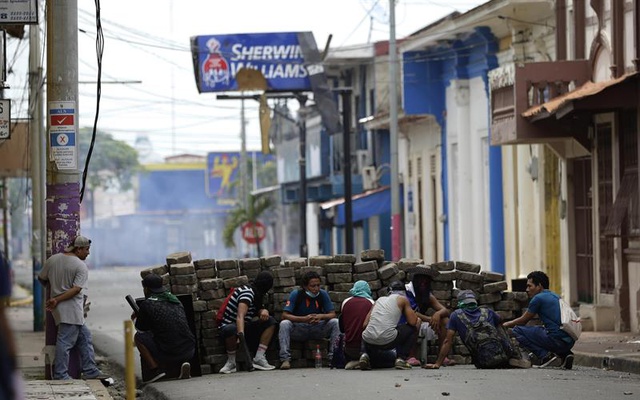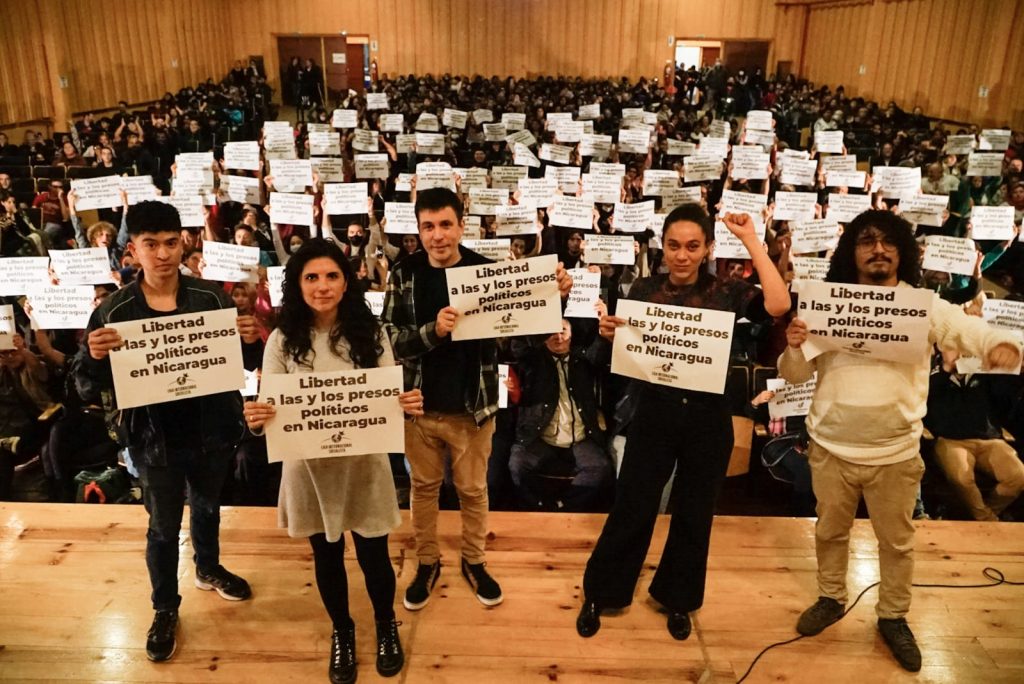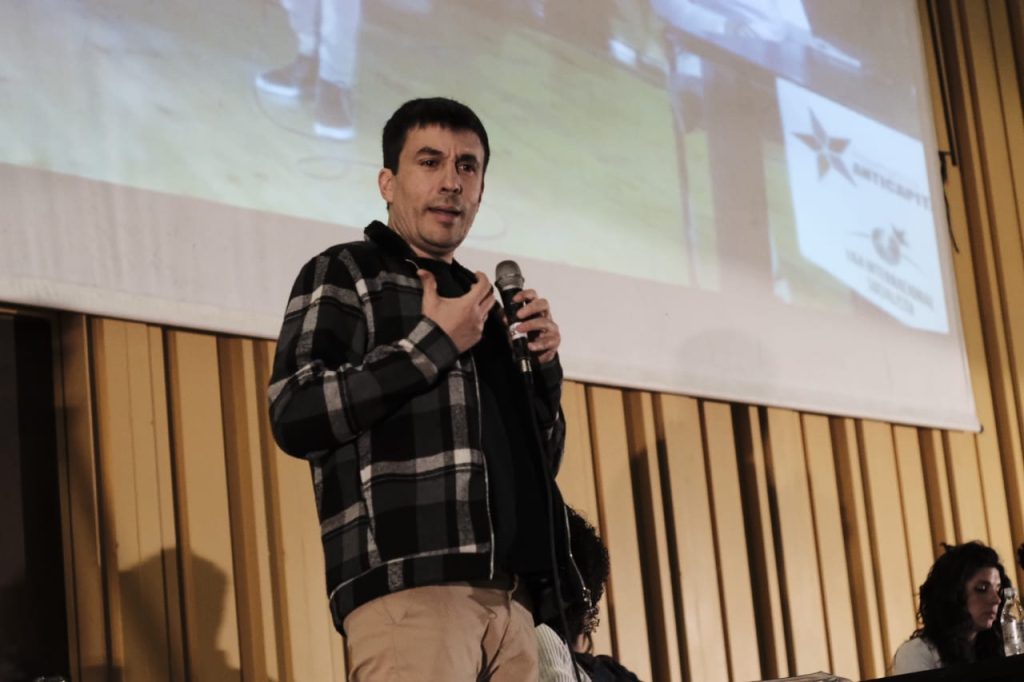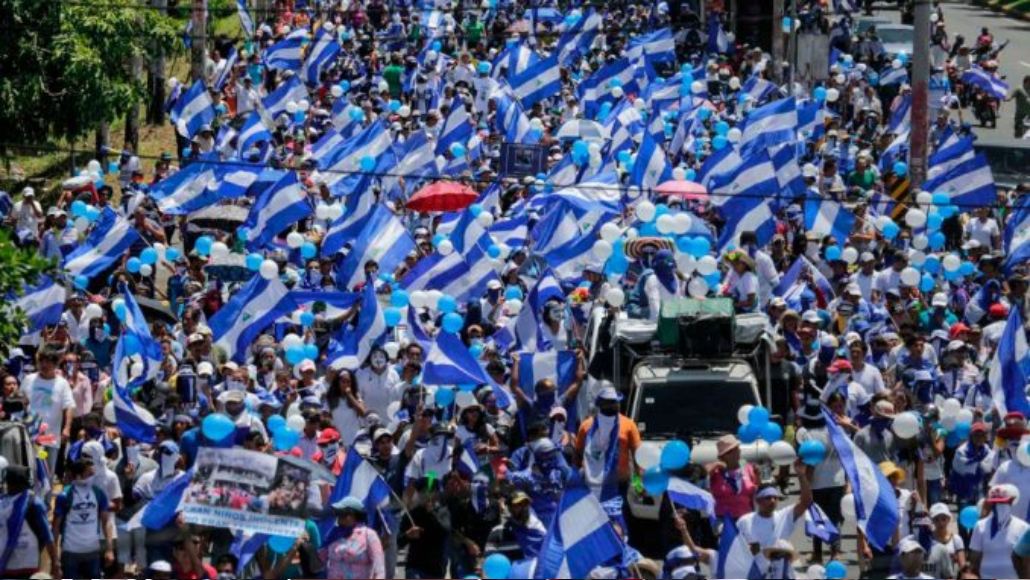La acción de la LIS y la Comisión Internacional por la vida y la libertad de las personas presas políticas en Nicaragua, dejó conclusiones y debates abiertos. El régimen de Ortega-Murillo nos bloqueó el ingreso al país, pero no nos va a impedir cumplir con varios objetivos. El primero es difundir al mundo, la realidad completa de lo que ocurre en aquella nación. La recolección de testimonios para la elaboración de una Relatoría Final; la interacción con protagonistas del proceso político desde 2018 y mucho antes también, nos permite ir armando para clarificar un verdadero rompecabezas. La radiografía integral de una realidad vista desde una posición crítica de izquierda que no encubre, silencia, ni justifica. Explica, aporta información y pone el cuerpo.
Escribe: Mariano Rosa, coordinador de la Comisión Internacional en representación de la LIS
El rol de la Comisión Internacional se transformó en un acontecimiento político muy relevante en el exilio nicaragüense y en especial, en la resistencia organizada desde Costa Rica, país limítrofe con Nicaragua. Las consecuencias de esa intervención coordinada por la LIS, fueron muy potentes:
*Frente a una geopolítica internacional gravitando hacia Europa del Este con la guerra en Ucrania, fue muy meritorio poner en agenda la situación en Nicaragua.
*La acción represiva de Ortega-Murillo que logró replegar al movimiento en su contra también provocó desmoralización, escepticismo y confusiones. Lógicamente, un contexto así explica las divisiones y tensiones entre grupos y colectivos. La Comisión logró rearticular una unidad bien amplia de todo el riquísimo arco de la resistencia en el exilio. Es otro punto a favor, importante.
*Sin exagerar, la determinación de llegar hasta la frontera y presentar un desafío directo, físico, a la dictadura, sorprendió al dúo gobernante. Eso forzó una respuesta militar desproporcionada en la frontera, su cierre inédito y días después, precipitó la remoción del embajador en Costa Rica.
*Para finalizar, hacerlo todo, desde una posición de izquierda canceló la posibilidad de invocar el argumento de que actuábamos como correa de transmisión de la Casa Blanca. Por supuesto, toda esta orientación, moralizó, sembró expectativas en organizaciones y familiares, y planteó tareas. En lo inmediato, la elaboración de un Informe que estará listo en las próximas semanas y será, seguramente, un nuevo acontecimiento. Pero, queremos reforzar un aspecto crucial de toda esta movida internacionalista: mostrar la otra Nicaragua, esa que ni las derechas, ni el progresismo encubridor quieren exhibir.
Un país cárcel
Queremos graficar lo que ocurre en Nicaragua, en materia de violación a todas las libertades democráticas, con ejemplos documentados de testimonios que recogimos y de pruebas que recolectamos.
*Desde abril de 2018 hasta ahora, hay casi 400 asesinatos por protestar. Esa cifra, supere los crímenes de Somoza, en su primera década de dictadura.
*La “Operación Limpieza”: se ejecutó durante julio de 2018 para barrer tranques, “cazar” opositores en sus casas y pulverizar todo vestigio de autoorganización y protesta, dejó decenas de muertos. La encabezaron fuerzas paramilitares.
*La Masacre de Carazo y el caso “Piel”: Carazo, al sur de Managua, fue epicentro de uno de los tranques más duros de todo el país. Hubo autodefensa armada y los paramilitares del FSLN fueron repelidos. La saña con la que fuer baleados con armamento de guerra este piquete, se recuerda como la “Masacre de Carazo”: 28 asesinados. Hace un mes, ahora en 2022, uno de sus liderazgos, Rodolgo Rojas, alias “Piel”, exiliado en Costa Roca como obrero de la construcción, fue secuestrado y su cuerpo apareció en la frontera con Honduras. Tenía disparos en la cabeza y el pecho a quemarropa. Además, tenía uñas y dientes arrancados. Gravísimo.
*Los presos políticos del Chipote: esta cárcel es el presidio político por antonomasia. Allí, liderazgos sociales y políticos son sometidos a torturas sistemáticas. Además de golpes, celdas de aislamiento y castigo, falta de atención médica, les han administrado varias veces comida contaminada. Hace casi 2 meses que los familiares no pueden visitar a sus seres queridos.
*El caso Jaime Navarrete: condenado a 22 años de cárcel por el delito de homicidio, que no fue probado. Este 24 de julio transcurrió su 4° cumpleaños en la cárcel. Fue amnistiado en 2019 y recapturado, la segunda vez acusado falsamente de tenencia de armas y drogas. Su familia denuncia incomunicación, torturas y aislamiento.
*El caso Parajón: Jimmy Parajón con poco más de 30 años, apoyó las protestas juveniles de abril de 2018. Fue asesinado de un tiro en el pecho con un arma de guerra. Yader, su hermano, a partir de allí se convirtió en activo participante de las movilizaciones contra el régimen. Fue encarcelado, amnistiado y recapturado. En febrero de este año un juicio-farsa, lo condenó por “conspiración” a 10 años de cárcel.
*Los “aguadores”: un grupo de 16 jóvenes en Masaya se solidarizaron llevando agua a un grupo de madres y familiares de presos, que se refugiaban en la iglesia de San Miguel haciendo huelga de hambre. Desafiaron el cerco policial y llegaron hasta las personas acantonadas. En noviembre de 2018 fueron capturados y encarcelados. Sufrieron meses de cárcel y torturas.
*La prensa y el exilio forzado: el régimen cerró 38 medios de comunicación y hay según estimaciones casi 200 periodistas en el exilio. Hubo persecución, cárcel y confiscaciones de edificios.
*La eliminación de expedientes académicos: el régimen expulsó activistas de las universidades públicos y eliminó sus expedientes académicos. Así, estudiantes con 4 o 5 años de cursada vieron truncadas sus carreras.
*900 organizaciones prohibidas: desde ONG´s filantrópicas hasta colectivos feministas, fueron prohibidos y sus patrimonios y sedes sociales, confiscados.
*Estado Policial y de Sitio no declarado: en Nicaragua no hay derecho a la protesta, no hay derecho de reunión, ni de ningún tipo. La delación institucionalizada, además, funciona en cada barrio y dependencia pública. Es un régimen que convirtió al país, en cárcel. ¿Si esto no es dictadura, cómo se llama? A las cosas por su nombre. Nada que justificar, todo por combatir.

La matriz económica, el imperialismo y los privilegios de clase: dictadores y capitalistas.
Para el caso de Nicaragua se da una colaboración objetiva entre derechas y progresismos (incluyendo a los decadentes Partidos Comunistas) en la tarea de encubrir, parcializar o silenciar un aspecto fundamental de todo el proyecto que encabezan Ortega-Murillo: el carácter social de los intereses que representan, la matriz económica que defienden. Antes, de calificarla, vamos a describirla.
*El país del que estamos hablando cuenta con una superficie territorial de 11,9 millones de hectáreas, existen 229 concesiones de megaminería metálica al año 2021, que abarcan 2,8 millones de hectáreas y representan el 23% de la superficie territorial del país. Ortega-Murillo, otorgó 114 de esas concesiones, siendo por lejos el gobierno que más territorio entregó al capital imperialista.
*Albanisa es una empresa que se constituyó como un mecanismo fraudulento para privatizar, en favor de Ortega, los subsidios del petróleo venezolano. Los fondos se canalizaron como una operación entre empresas privadas, a pesar de que tenían su origen en un convenio internacional. Según datos oficiales del Banco Central, el monto total de los créditos canalizados por Albanisa, a junio del 2018, se aproximan a 4000 millones de dólares. Llegó a promediar 500 millones de dólares anuales. Un capital líquido que Ortega gestionó discrecionalmente, como capital privado.
*Desde esa empresa como cobertura de negocios de la pareja gobernante, esta “diversificó” sus inversiones: Albageneración, la principal empresa generadora de energía eléctrica. Albadepósitos, dedicada a la importación, almacenamiento y distribución de petróleo y derivados. Albaforestal, cuyo negocio es la madera. Albaequipos (Econsa), empresa de servicios y construcción. DNP, empresa distribuidora de combustible. Hasta una empresa de vigilancia aparece en el amplio listado. Todo bajo control directo de la dictadura.
Pero, usufructuar para la fortuna personal utilizando su posición en el Estado, no fue todo: también había que legalizar el encubrimiento. Así con el apoyo de la Corte Suprema de Justicia, se transformó en secreto el Registro Público de la Propiedad. Vale decir: nadie puede desde antes de 2018 saber quiénes tienen qué propiedad.
*La joya de la fortuna personal de los Ortega-Murillo es Bancorp. Después de 2018, este banco privado recibió un fideicomiso con patrimonios transferidos de otras empresas, prestadoras de servicios al Estado de Nicaragua. El monto patrimonial de Bancorp asciende a 2500 millones de dólares. Esa cifra es un punto de referencia estimativo, de la fortuna personal de Ortega-Murillo.Es decir: son dictadores, para erradicar toda oposición real. Pero esencialmente, son represores para preservar la impunidad que les asegure seguir lucrando y enriqueciéndose ellos y su entorno. Ni antiimperialistas, ni de izquierda: son capitalistas, burgueses emergentes de un país saqueado y con vínculos con el gran capital internacional.
¿Esta es la matriz progresista y de izquierda asediada por el imperialismo que no hay que criticar para no ser funcionales a la embajada yanqui? Ridículo. Y datos, categóricas. Dato mata narrativa.

Nuestras tesis de abril (versión 2018) y la contrarrevolución del FSLN
En abril de 2018 se produjo una verdadera semi-insurrección. Una rebelión masiva, que paralizó al poder político, que acorraló al gobierno del FSLN y que replegó a todo el enorme aparato militar-policial-parapolicial.
*Hubo cerca de 150 piquetes en todo el país.
*Las principales universidades, ocupadas. *Barricadas y autodefensa armada durante semanas. *Convergencia en la acción de viejos cuadros del sandinismo crítico, el movimiento campesino independiente y una joven generación estudiantil –y de los barrios populares- que elevaron el programa de la rebelión a la exigencia de que se fueran Ortega-Murillo.
La dictadura entró en pánico. Nunca había sido desafiado a tan gran escala y nunca había estado tan socialmente aislada. Con olfato agudo entendió que se estaba gestando potencialmente un adversario en las calles que amenazaba seriamente negocios e impunidad. De allí, a partir de esta certera caracterización, la magnitud que explica la institucionalización de la represión a escala general.El FSLN planifica y ejecuta una contrarrevolución en toda la línea. De allí su criminalidad de lesa humanidad. De allí lo implacable de su orientación. De allí, su naturaleza genocida. Es a todo o nada. Se juegan fortunas y cárcel. Todo para perder. De allí el ensañamiento y brutalidad. Así se explica. Por eso, en el contexto de una rebelión masiva, el rol de la cúpula de la Iglesia y el gran empresariado representado por el COSEP, fue nefasto e instrumental a Ortega-Murillo: el diálogo dividió aguas en el movimiento rebelde y aisló al ala más luchadora, que sin centralización nacional fue siendo derrotada trinchera por trinchera. Importante moraleja en este tramo del balance: sin centralización nacional que concentre la energía de semejante movimiento, no hay chance de derrotar un régimen contrarrevolucionario entrenadísimo para la represión. Aprender, para no repetir.

Tres debates en curso y la contribución de la LIS
Todo proceso de rebelión y respuesta brutal, como la de la dictadura en Nicaragua, abre polémicas, debates, incertidumbres y matices entre las organizaciones, y su activismo. Es casi una ley. En ese contexto, queremos dar breve y esquemáticamente, nuestra visión.
Debate 1: ¿cómo terminar con la dictadura?
Hay una historia de enorme violencia política, muertes y frustración en el pueblo nica. Sandino primero, en la década de 1930. Después, la lucha contra Somoza, 40 años de dictadura. La revolución de 1979 y la guerra civil frente a los Contra. Ahora, desde 2018, otra vez, dictadura, exilio, muertos. Es comprensible la penetración de la falsa salida de los “diálogos” que terminan haciendo bajar la guardia a la resistencia y de las salidas institucionales, controladas por desde arriba. Hay una experiencia recorrida con la intervención del gran empresariado y la cúpula clerical. Todo ese camino llevó a un callejón sin salida, y lo capitalizaron Ortega-Murillo. El único momento en que la dictadura estuvo paralizada, impotente y al borde del precipicio fue con la masiva movilización popular. Evidentemente, a las pruebas nos remitimos: ese es el recurso más potente de todo pueblo en lucha, incluyendo el derecho a la autodefensa armada. Siempre con autoorganización democrática y centralización coordinada. En el plano internacional, cercar a la pareja gobernante. Aislar al régimen y oxigenar a la resistencia interna. Es por ahí, estamos convencidos.
Debate 2: ¿hay dos etapas?
Este es un tema recurrente, y otro punto clave. El día después de la dictadura no está separado, de la pelea actual por echarla, revolucionariamente con la movilización masiva. En realidad, el programa es uno solo con una combinación de tareas, que arrancan por la vida y la libertad de las y los presos políticos, echar a la dictadura y a partir de ahí, una reorganización democrática, libre y soberana a través de un proceso constituyente hacia otra Nicaragua y un gobierno de los que nunca gobernaron: los trabajadores, el pueblo pobre, sin capitalistas, sin represores. Por lo tanto, la necesidad de una estrategia política global, que combine unidad de acción para echar a Ortega-Murillo, y a la vez, delimitación estratégica de todo campo empresarial y amigo del poder gringo, desde ahora, es fundamental. Sin eso, la juventud, el exilio, el campesinado va a volver a poner los muertos y los sacrificios, y los que al final cabalgan sobre ese esfuerzo, terminan secuestrando el poder político para retomar sus negocios de minoría. No se puede permitir.
Debate 3: ¿la experiencia del FSLN (y aliados) impugna todo proyecto de izquierda?
El sandinismo burgués, capitalista, dictatorial y verdugo de su pueblo, arrastró por el piso la bandera de la izquierda y el antiimperialismo. Sus aliados regionales, como el PC de Cuba o el chavismo senil, suman su cuota de confusionismo. Pero esos proyectos no tienen nada que ver con el socialismo o las concepciones emancipatorias que defendemos, por ejemplo, desde la LIS. Somos izquierda con visión internacionalista, y en eso, sin compromiso con ninguna potencia capitalista, promovemos la más amplia democracia política para decidir todo: en un país gobernado por los de abajo, en la propia organización para deliberar, construir política, controlar a los dirigentes y decidir todo. Sin eso, en un país o en la propia organización, hay burocracia, privilegios y reversión conservadora y reaccionaria de cualquier positivo proceso de cambio. Es la experiencia del estalinismo en la ex URSS. Es la experiencia del chavismo que no avanzó. Obviamente, del FSLN de arranque, cohabitando con sectores empresariales. Y claro, Cuba y el aberrante régimen de partido único. Habemus otra izquierda, y en crecimiento.
La contribución de la Liga Internacional Socialista
Nuestra organización internacional, la LIS, animadora de la Comisión, tiene mucho todavía para aportar a la causa nica, que es latinoamericana y mundial. Primero, nos proponemos ser los mejores militantes de la más amplia unidad de acción, por las prioridades emergentes: la vida, la libertad de los rehenes de la dictadura y que se vayan Ortega-Murillo y su régimen. En eso, no tenemos la más mínima duda. Pero, a la vez, es esencial construir un tercer campo político que combata a la dictadura de forma consecuente, pero que sea bien independiente de toda injerencia gringa. Ningún imperialismo tiene que intervenir en nada después de echar al clan gobernante. Nuestra experiencia directa con lo mejor del exilio en resistencia, nos hizo constatar que estamos frente a una posibilidad que dependerá de lo que hagamos: sintetizar en una poderosa confluencia, cuadros y militantes que han roto con el sandinismo de forma autocrítica; el activismo joven “generación de abril 2018” y una fuerza como la LIS, que son su sección nicaragüense, Alternativa Anticapitalista, en proceso de construcción, se propone como articulador de todas esas vertientes. En este convergente cruce de caminos está la posibilidad desde ahora, de construir un proyecto político que exprese las mejores aspiraciones de ese extraordinario pueblo rebelde de Nicaragua. De nuestra parte, orgullosos de poder ocupar un puesto de lucha en esta apasionante trinchera centroamericana.
Mariano Rosa




